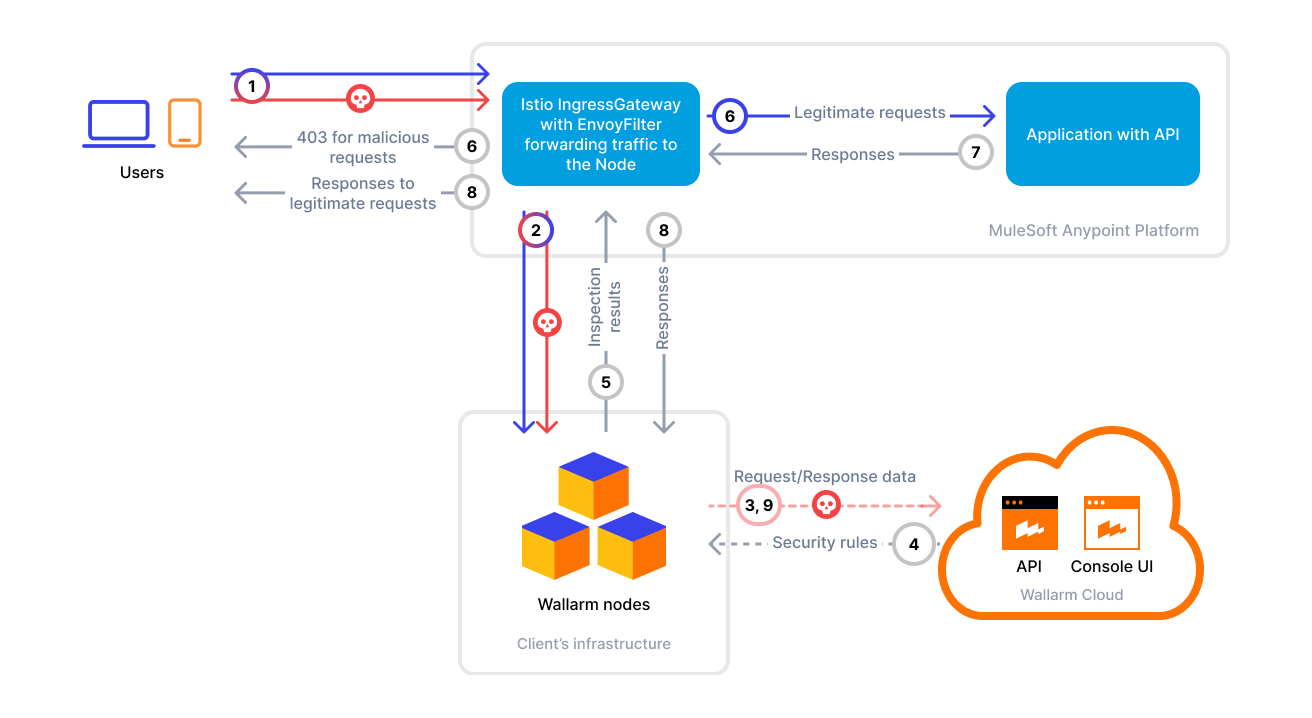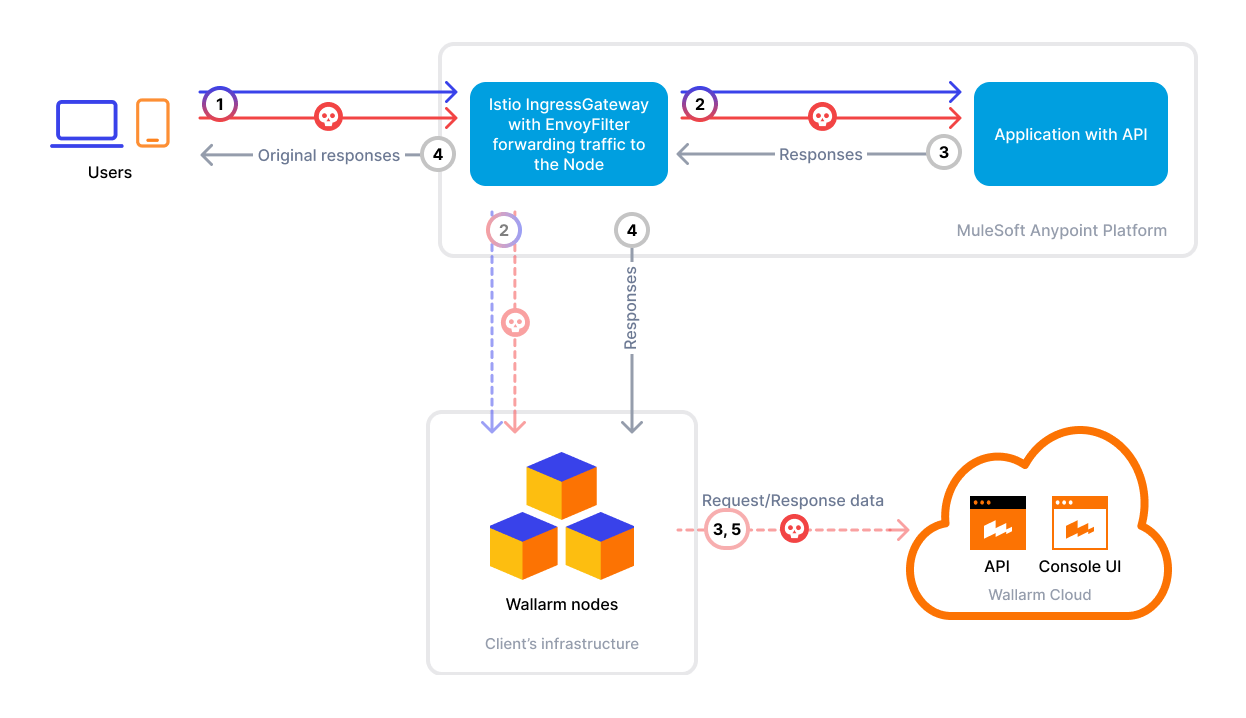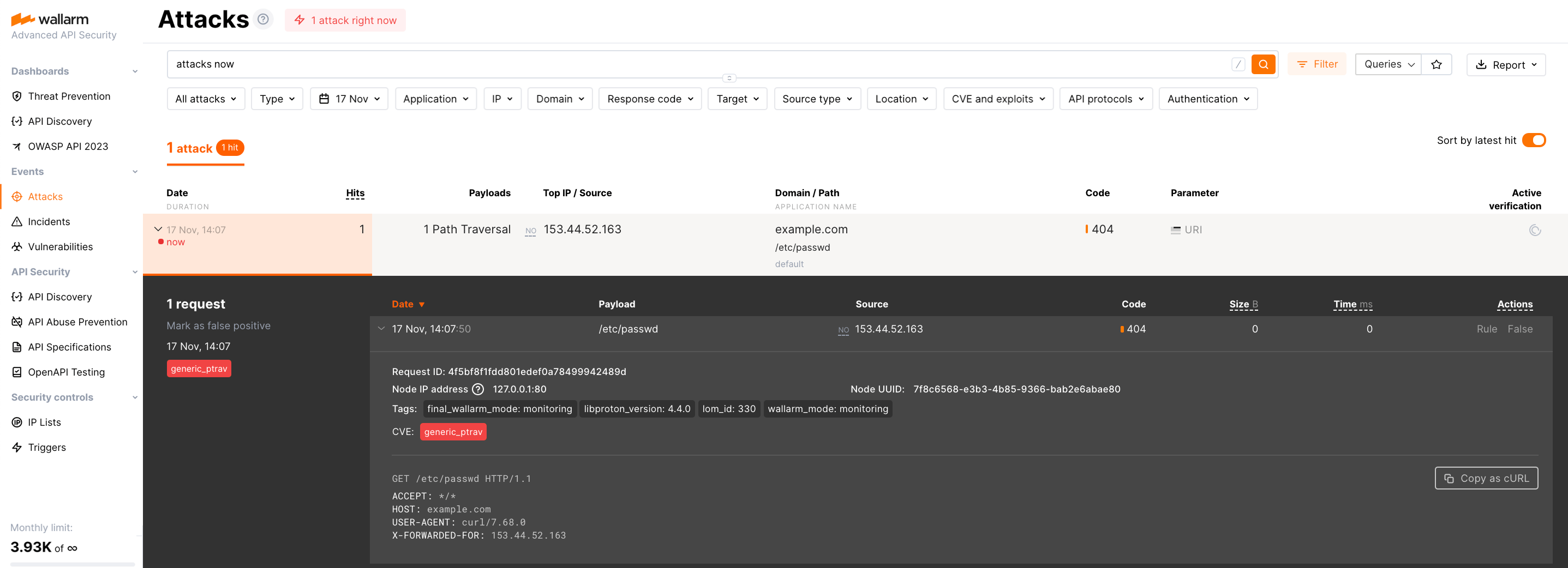Wallarm Filter for Istio Ingress¶
This guide describes how to secure your APIs managed by Istio using the Wallarm Connector for Istio Ingress.
To use Wallarm with Istio, you need to deploy a Wallarm Node (either externally or within your cluster) and apply a gRPC-based External Processing filter (ext_proc) in Envoy to forward traffic to the Node for analysis.
The Wallarm connector for Istio ingress supports both synchronous (in-line) and asynchronous (out‑of‑band) traffic analysis:
Use cases¶
This connector is the optimal choice when you need protection for workloads managed by Istio and Envoy.
Limitations¶
-
A trusted SSL/TLS certificate is required for the Wallarm Node domain. Self-signed certificates are not supported.
-
Custom blocking page and blocking code configurations are not yet supported.
All blocked malicious traffic is returned with status code
403and the default block page. -
Rate limiting by Wallarm rules is not supported.
Rate limiting cannot be enforced on the Wallarm side for this connector. If you need rate limiting, use the features built into your API gateway or cloud platform.
Requirements¶
Before deploying the connector, make sure that:
-
You have a Kubernetes cluster with Istio installed
-
Envoy v1.30.0+ is used
-
Applications are deployed and reachable through an Istio Gateway and VirtualService
-
Access to the Administrator account in Wallarm Console for the US Cloud or EU Cloud
-
A Wallarm Native Node v0.13.0+ is used
-
A trusted TLS certificate and private key are available for the domain used by the Node
Deployment¶
1. Deploy a Wallarm Node¶
The Wallarm node is a core component of the Wallarm platform that you need to deploy. It inspects incoming traffic, detects malicious activities, and can be configured to mitigate threats.
Choose an artifact for a self-hosted node deployment and follow the instructions attached for the envoy-external-filter mode:
-
All-in-one installer for Linux infrastructures on bare metal or VMs
-
Docker image for environments that use containerized deployments
-
AWS AMI for AWS infrastructures
-
Helm chart for infrastructures utilizing Kubernetes
2. Configure Istio (Envoy) to forward traffic to the Wallarm Node¶
Add the Wallarm filter to your Istio IngressGateway using the External Processing (ext_proc) filter.
You can either create a new EnvoyFilter in the istio-system namespace (recommended) or modify your existing one.
If you already have a gateway EnvoyFilter, merge the HTTP_FILTER and CLUSTER patches into it.
If your Wallarm Node is publicly reachable¶
apiVersion: networking.istio.io/v1alpha3
kind: EnvoyFilter
metadata:
name: wallarm-filter
namespace: istio-system
spec:
configPatches:
- applyTo: HTTP_FILTER
match:
context: GATEWAY
listener:
filterChain:
filter:
name: "envoy.filters.network.http_connection_manager"
patch:
operation: INSERT_BEFORE
value:
name: envoy.filters.http.ext_proc
typed_config:
"@type": type.googleapis.com/envoy.extensions.filters.http.ext_proc.v3.ExternalProcessor
grpc_service:
envoy_grpc:
cluster_name: wallarm_cluster
processing_mode:
request_body_mode: STREAMED
response_body_mode: STREAMED
request_attributes: ["request.id", "request.time", "source.address"]
failure_mode_allow: <TRUE/FALSE>
- applyTo: CLUSTER
match:
context: GATEWAY
patch:
operation: ADD
value:
name: wallarm_cluster
connect_timeout: 30s
type: STRICT_DNS
load_assignment:
cluster_name: wallarm_cluster
endpoints:
- lb_endpoints:
- endpoint:
address:
socket_address:
address: <WALLARM_NODE_FQDN>
port_value: 5080
http2_protocol_options: {}
transport_socket:
name: envoy.transport_sockets.tls
typed_config:
"@type": type.googleapis.com/envoy.extensions.transport_sockets.tls.v3.UpstreamTlsContext
common_tls_context:
validation_context:
match_subject_alt_names:
- exact: <WALLARM_NODE_FQDN>
trusted_ca:
filename: /etc/ssl/certs/ca-certificates.crt
apiVersion: networking.istio.io/v1alpha3
kind: EnvoyFilter
metadata:
name: wallarm-filter
namespace: istio-system
spec:
configPatches:
- applyTo: HTTP_FILTER
match:
context: GATEWAY
listener:
filterChain:
filter:
name: "envoy.filters.network.http_connection_manager"
patch:
operation: INSERT_BEFORE
value:
name: envoy.filters.http.ext_proc
typed_config:
"@type": type.googleapis.com/envoy.extensions.filters.http.ext_proc.v3.ExternalProcessor
grpc_service:
envoy_grpc:
cluster_name: wallarm_cluster
processing_mode:
request_body_mode: STREAMED
response_body_mode: STREAMED
request_attributes: ["request.id", "request.time", "source.address"]
failure_mode_allow: <TRUE/FALSE>
observability_mode: true
- applyTo: CLUSTER
match:
context: GATEWAY
patch:
operation: ADD
value:
name: wallarm_cluster
connect_timeout: 30s
type: STRICT_DNS
load_assignment:
cluster_name: wallarm_cluster
endpoints:
- lb_endpoints:
- endpoint:
address:
socket_address:
address: <WALLARM_NODE_FQDN>
port_value: 5080
http2_protocol_options: {}
transport_socket:
name: envoy.transport_sockets.tls
typed_config:
"@type": type.googleapis.com/envoy.extensions.transport_sockets.tls.v3.UpstreamTlsContext
common_tls_context:
validation_context:
match_subject_alt_names:
- exact: <WALLARM_NODE_FQDN>
trusted_ca:
filename: /etc/ssl/certs/ca-certificates.crt
-
request_body_mode: STREAMEDandresponse_body_mode: STREAMED— may cause Envoy to use chunked transfer encoding for the backend. Ensure that your backend supports chunked decoding; otherwise, requests may fail.Use
BUFFEREDorBUFFERED_PARTIAL, or ensure backend compatibility with chunked encoding if needed. -
failure_mode_allow— defines the behavior if the Wallarm Node is unreachable:true: fail-open (traffic continues without analysis)false: fail-closed (traffic rejected with500)
-
<WALLARM_NODE_FQDN>— your Wallarm Node FQDN, without protocol or trailing slash. -
port_value: 5080— change if the Wallarm Node listens on another port. -
The
connect_timeoutparameter defines how long Envoy waits to establish a connection with the Wallarm Node before considering it failed.The example value of
30sworks for most environments. However, under heavy load or network congestion, a long timeout may delay fail-open behavior and cause traffic to stall. In such cases, consider reducing the timeout — for example, to10s(the Istio default for TCP connections).
Apply the configuration:
If your Wallarm Node is internal (ClusterIP)¶
apiVersion: v1
items:
- apiVersion: networking.istio.io/v1alpha3
kind: EnvoyFilter
metadata:
annotations:
kubectl.kubernetes.io/last-applied-configuration: |
{"apiVersion":"networking.istio.io/v1alpha3","kind":"EnvoyFilter","metadata":{"annotations":{},"name":"wallarm-filter","namespace":"istio-system"},"spec":{"configPatches":[{"applyTo":"HTTP_FILTER","match":{"context":"GATEWAY","listener":{"filterChain":{"filter":{"name":"envoy.filters.network.http_connection_manager"}}}},"patch":{"operation":"INSERT_BEFORE","value":{"name":"envoy.filters.http.ext_proc","typed_config":{"@type":"type.googleapis.com/envoy.extensions.filters.http.ext_proc.v3.ExternalProcessor","failure_mode_allow":false,"grpc_service":{"envoy_grpc":{"cluster_name":"wallarm_cluster"}},"processing_mode":{"request_body_mode":"STREAMED","response_body_mode":"STREAMED"},"request_attributes":["request.id","request.time","source.address"]}}}},{"applyTo":"CLUSTER","match":{"context":"GATEWAY"},"patch":{"operation":"ADD","value":{"connect_timeout":"30s","load_assignment":{"cluster_name":"wallarm_cluster","endpoints":[{"lb_endpoints":[{"endpoint":{"address":{"socket_address":{"address":"native-processing.wallarm.svc.cluster.local","port_value":5080}}}}]}]},"name":"wallarm_cluster","type":"STRICT_DNS"}}}]}}
creationTimestamp: "2025-06-04T01:41:30Z"
generation: 5
name: wallarm-filter
namespace: istio-system
resourceVersion: "49980160"
uid: db2ec99d-2a65-4694-8773-0be30f3060f2
spec:
configPatches:
- applyTo: HTTP_FILTER
match:
context: GATEWAY
listener:
filterChain:
filter:
name: envoy.filters.network.http_connection_manager
patch:
operation: INSERT_BEFORE
value:
name: envoy.filters.http.ext_proc
typed_config:
'@type': type.googleapis.com/envoy.extensions.filters.http.ext_proc.v3.ExternalProcessor
failure_mode_allow: <TRUE/FALSE>
grpc_service:
envoy_grpc:
cluster_name: wallarm_cluster
processing_mode:
request_body_mode: STREAMED
response_body_mode: STREAMED
request_attributes:
- request.id
- request.time
- source.address
- applyTo: CLUSTER
match:
context: GATEWAY
patch:
operation: ADD
value:
connect_timeout: 30s
http2_protocol_options: {}
load_assignment:
cluster_name: wallarm_cluster
endpoints:
- lb_endpoints:
- endpoint:
address:
socket_address:
address: <HOST.DOMAIN.COM>
port_value: 5080
name: wallarm_cluster
transport_socket:
name: envoy.transport_sockets.tls
typed_config:
'@type': type.googleapis.com/envoy.extensions.transport_sockets.tls.v3.UpstreamTlsContext
common_tls_context:
validation_context:
match_subject_alt_names:
- exact: <HOST.DOMAIN.COM>
trusted_ca:
filename: /etc/ssl/certs/ca-certificates.crt
type: STRICT_DNS
apiVersion: v1
items:
- apiVersion: networking.istio.io/v1alpha3
kind: EnvoyFilter
metadata:
annotations:
kubectl.kubernetes.io/last-applied-configuration: |
{"apiVersion":"networking.istio.io/v1alpha3","kind":"EnvoyFilter","metadata":{"annotations":{},"name":"wallarm-filter","namespace":"istio-system"},"spec":{"configPatches":[{"applyTo":"HTTP_FILTER","match":{"context":"GATEWAY","listener":{"filterChain":{"filter":{"name":"envoy.filters.network.http_connection_manager"}}}},"patch":{"operation":"INSERT_BEFORE","value":{"name":"envoy.filters.http.ext_proc","typed_config":{"@type":"type.googleapis.com/envoy.extensions.filters.http.ext_proc.v3.ExternalProcessor","failure_mode_allow":false,"grpc_service":{"envoy_grpc":{"cluster_name":"wallarm_cluster"}},"processing_mode":{"request_body_mode":"STREAMED","response_body_mode":"STREAMED"},"request_attributes":["request.id","request.time","source.address"]}}}},{"applyTo":"CLUSTER","match":{"context":"GATEWAY"},"patch":{"operation":"ADD","value":{"connect_timeout":"30s","load_assignment":{"cluster_name":"wallarm_cluster","endpoints":[{"lb_endpoints":[{"endpoint":{"address":{"socket_address":{"address":"native-processing.wallarm.svc.cluster.local","port_value":5080}}}}]}]},"name":"wallarm_cluster","type":"STRICT_DNS"}}}]}}
creationTimestamp: "2025-06-04T01:41:30Z"
generation: 5
name: wallarm-filter
namespace: istio-system
resourceVersion: "49980160"
uid: db2ec99d-2a65-4694-8773-0be30f3060f2
spec:
configPatches:
- applyTo: HTTP_FILTER
match:
context: GATEWAY
listener:
filterChain:
filter:
name: envoy.filters.network.http_connection_manager
patch:
operation: INSERT_BEFORE
value:
name: envoy.filters.http.ext_proc
typed_config:
'@type': type.googleapis.com/envoy.extensions.filters.http.ext_proc.v3.ExternalProcessor
failure_mode_allow: <TRUE/FALSE>
observability_mode: true
grpc_service:
envoy_grpc:
cluster_name: wallarm_cluster
processing_mode:
request_body_mode: STREAMED
response_body_mode: STREAMED
request_attributes:
- request.id
- request.time
- source.address
- applyTo: CLUSTER
match:
context: GATEWAY
patch:
operation: ADD
value:
connect_timeout: 30s
http2_protocol_options: {}
load_assignment:
cluster_name: wallarm_cluster
endpoints:
- lb_endpoints:
- endpoint:
address:
socket_address:
address: <HOST.DOMAIN.COM>
port_value: 5080
name: wallarm_cluster
transport_socket:
name: envoy.transport_sockets.tls
typed_config:
'@type': type.googleapis.com/envoy.extensions.transport_sockets.tls.v3.UpstreamTlsContext
common_tls_context:
validation_context:
match_subject_alt_names:
- exact: <HOST.DOMAIN.COM>
trusted_ca:
filename: /etc/ssl/certs/ca-certificates.crt
type: STRICT_DNS
-
failure_mode_allow— defines the behavior if the Wallarm Node is unreachable:true: fail-open (traffic continues without analysis)false: fail-closed (traffic rejected with500)
-
request_body_mode: STREAMEDandresponse_body_mode: STREAMED— may cause Envoy to use chunked transfer encoding for the backend. Ensure that your backend supports chunked decoding; otherwise, requests may fail.Use
BUFFEREDorBUFFERED_PARTIAL, or ensure backend compatibility with chunked encoding if needed. -
<HOST.DOMAIN.COM>— the fully qualified domain name (FQDN) of your Wallarm Node, without protocol or trailing slash.This must be the same domain for which the SSL/TLS certificate was issued and which resolves internally to the Node’s service (e.g., through a CoreDNS rewrite).
-
port_value: 5080— change if the Wallarm Node listens on another port. -
The
connect_timeoutparameter defines how long Envoy waits to establish a connection with the Wallarm Node before considering it failed.The example value of
30sworks for most environments. However, under heavy load or network congestion, a long timeout may delay fail-open behavior and cause traffic to stall. In such cases, consider reducing the timeout — for example, to10s(the Istio default for TCP connections).
Apply the configuration:
3. Optional: AWS kOps proxy protocol support¶
For AWS kOps clusters, enable proper X-Forwarded-For propagation:
kubectl patch svc istio-ingressgateway -n istio-system \
--type=merge \
-p '{"metadata":{"annotations":{"service.beta.kubernetes.io/aws-load-balancer-proxy-protocol":"*"}}}'
kubectl edit configmap -n istio-system istio
Then add:
Testing¶
To test the functionality of the deployed filter, follow these steps:
-
Send the request with the test Path Traversal attack:
-
Open Wallarm Console → Attacks section in the US Cloud or EU Cloud and make sure the attack is displayed in the list.
If the Wallarm node mode is set to blocking and the traffic flows in-line, the request will also be blocked.
Advanced configuration options¶
In addition to the basic EnvoyFilter examples described above (which apply Wallarm filtering to all Istio Ingress Gateway traffic), you can use the following alternative configurations to handle more specific use cases:
-
Limit Wallarm inspection to selected domains or namespaces
-
Mirror intra-cluster traffic in addition to external ingress traffic
-
Exclude certain routes or services from inspection
Filter only selected domains (external traffic only)¶
If you prefer to manage a single EnvoyFilter in the istio-system namespace and prevent other namespaces from disabling inspection, use this configuration.
It mirrors only specific domains defined by their SNI values:
apiVersion: networking.istio.io/v1alpha3
kind: EnvoyFilter
metadata:
annotations:
name: wallarm-filter
namespace: istio-system
spec:
configPatches:
######
## COPY AND PASTE THIS SECTION FOR EVERY DOMAIN YOU WANT TO INSPECT
## MODIFY ONLY THE match.listener.filterChain.sni VALUE
######
- applyTo: HTTP_FILTER
match:
context: GATEWAY
listener:
filterChain:
sni: <APP_DOMAIN>
filter:
name: envoy.filters.network.http_connection_manager
patch:
operation: INSERT_BEFORE
value:
name: envoy.filters.http.ext_proc
typed_config:
'@type': type.googleapis.com/envoy.extensions.filters.http.ext_proc.v3.ExternalProcessor
failure_mode_allow: false
grpc_service:
envoy_grpc:
cluster_name: wallarm_cluster
processing_mode:
request_body_mode: STREAMED
response_body_mode: STREAMED
request_attributes:
- request.id
- request.time
- source.address
########
## END COPY/PASTE SECTION
########
########
## PASTE ANY OTHER DOMAINS TO INSPECT HERE BEFORE THE CLUSTER CONFIG
########
- applyTo: CLUSTER
match:
context: GATEWAY
patch:
operation: ADD
value:
connect_timeout: 30s
http2_protocol_options: {}
load_assignment:
cluster_name: wallarm_cluster
endpoints:
- lb_endpoints:
- endpoint:
address:
socket_address:
address: <WALLARM_NODE_FQDN>
port_value: <PORT>
name: wallarm_cluster
transport_socket:
name: envoy.transport_sockets.tls
typed_config:
'@type': type.googleapis.com/envoy.extensions.transport_sockets.tls.v3.UpstreamTlsContext
common_tls_context:
validation_context:
match_subject_alt_names:
- exact: <WALLARM_NODE_FQDN>
trusted_ca:
filename: /etc/ssl/certs/ca-certificates.crt
type: STRICT_DNS
Filter selected domains (intra-cluster + external traffic)¶
You can also deploy an EnvoyFilter inside each application namespace to inspect not only ingress but also service-to-service (sidecar) traffic.
This setup supports Istio's internal mTLS and client-side mTLS:
# NOTE THE spec.configPatches.applyTo.match.context ARE FOR SIDECAR NOT GATEWAY
# IF YOU ALSO WANT TO INSPECT OUTBOUND REQUESTS THE APP MAKES, ADD ANOTHER
# "- applyTo: HTTP_FILTER" WITH "context: SIDECAR_OUTBOUND"
apiVersion: networking.istio.io/v1alpha3
kind: EnvoyFilter
metadata:
name: wallarm-filter
spec:
configPatches:
- applyTo: HTTP_FILTER
match:
context: SIDECAR_INBOUND
listener:
filterChain:
filter:
name: envoy.filters.network.http_connection_manager
patch:
operation: INSERT_BEFORE
value:
name: envoy.filters.http.ext_proc
typed_config:
'@type': type.googleapis.com/envoy.extensions.filters.http.ext_proc.v3.ExternalProcessor
failure_mode_allow: false
grpc_service:
envoy_grpc:
cluster_name: wallarm_cluster
processing_mode:
request_body_mode: STREAMED
response_body_mode: STREAMED
request_attributes:
- request.id
- request.time
- source.address
- applyTo: CLUSTER
match:
context: SIDECAR_OUTBOUND
patch:
operation: ADD
value:
connect_timeout: 30s
http2_protocol_options: {}
load_assignment:
cluster_name: wallarm_cluster
endpoints:
- lb_endpoints:
- endpoint:
address:
socket_address:
address: <WALLARM_NODE_FQDN>
port_value: <PORT>
name: wallarm_cluster
transport_socket:
name: envoy.transport_sockets.tls
typed_config:
'@type': type.googleapis.com/envoy.extensions.transport_sockets.tls.v3.UpstreamTlsContext
common_tls_context:
validation_context:
match_subject_alt_names:
- exact: <WALLARM_NODE_FQDN>
trusted_ca:
filename: /etc/ssl/certs/ca-certificates.crt
type: STRICT_DNS
Excluding specific domains or routes¶
If you have a complex routing setup and experience duplicated or unwanted mirrored traffic, you can exclude selected routes from inspection.
This method uses ExtProcPerRoute configuration and is based on the route.name label in your VirtualService objects:
-
Make sure that each
VirtualServicehas aspec.http[0].namefield specified — this name will be referenced when configuring exclusions:apiVersion: networking.istio.io/v1 kind: VirtualService metadata: name: httpbin-vs namespace: httpbin spec: gateways: - <GATEWAY> hosts: - <HOST> http: - match: - uri: prefix: / name: <ROUTE_NAME> ## <---- ENSURE NAME IS DEFINED FOR ALL VS OBJECTS route: - destination: host: httpbin port: number: 80 -
Deploy a single
EnvoyFilterin theistio-systemnamespace to mirror all ingress traffic and exclude selected routes based on their names.In the following example, all traffic is mirrored except for
httpbin2andhttpbin4, which are explicitly excluded:apiVersion: networking.istio.io/v1alpha3 kind: EnvoyFilter metadata: name: wallarm-route namespace: istio-system spec: workloadSelector: labels: istio: ingressgateway configPatches: # === 1. Apply the Wallarm ext_proc filter to all inbound traffic === - applyTo: HTTP_FILTER match: context: GATEWAY listener: filterChain: filter: name: envoy.filters.network.http_connection_manager patch: operation: INSERT_BEFORE value: name: envoy.filters.http.ext_proc typed_config: '@type': type.googleapis.com/envoy.extensions.filters.http.ext_proc.v3.ExternalProcessor failure_mode_allow: false grpc_service: envoy_grpc: cluster_name: wallarm_cluster processing_mode: request_body_mode: STREAMED response_body_mode: STREAMED request_attributes: - request.id - request.time - source.address # === 2. Define the Wallarm Node cluster for traffic mirroring === - applyTo: CLUSTER match: context: GATEWAY patch: operation: ADD value: name: wallarm_cluster connect_timeout: 30s type: STRICT_DNS load_assignment: cluster_name: wallarm_cluster endpoints: - lb_endpoints: - endpoint: address: socket_address: address: <WALLARM_NODE_FQDN> port_value: <PORT> http2_protocol_options: {} transport_socket: name: envoy.transport_sockets.tls typed_config: '@type': type.googleapis.com/envoy.extensions.transport_sockets.tls.v3.UpstreamTlsContext common_tls_context: validation_context: match_subject_alt_names: - exact: <WALLARM_NODE_FQDN> trusted_ca: filename: /etc/ssl/certs/ca-certificates.crt # === 3. Exclude specific routes from mirroring === # Example: Exclude httpbin2 - applyTo: HTTP_ROUTE match: context: GATEWAY routeConfiguration: vhost: name: httpbin2.example.com:443 route: name: httpbin2-route patch: operation: MERGE value: typed_per_filter_config: envoy.filters.http.ext_proc: '@type': type.googleapis.com/envoy.extensions.filters.http.ext_proc.v3.ExtProcPerRoute disabled: true # Example: Exclude httpbin4 - applyTo: HTTP_ROUTE match: context: GATEWAY routeConfiguration: vhost: name: httpbin4.example.com:443 route: name: httpbin4-route patch: operation: MERGE value: typed_per_filter_config: envoy.filters.http.ext_proc: '@type': type.googleapis.com/envoy.extensions.filters.http.ext_proc.v3.ExtProcPerRoute disabled: true
Manual setup (standalone Envoy)¶
If you are running Envoy outside Istio, insert the filter and cluster directly in your envoy.yaml:
-
In your
envoy.yaml→http_filterssection, configure the external processing filter for sending requests and responses to the external Wallarm Node for analysis:... http_filters: - name: ext_proc typed_config: "@type": type.googleapis.com/envoy.extensions.filters.http.ext_proc.v3.ExternalProcessor grpc_service: envoy_grpc: cluster_name: wallarm_cluster processing_mode: request_body_mode: STREAMED response_body_mode: STREAMED request_attributes: ["request.id", "request.time", "source.address"] -
In your
envoy.yaml→clusterssection, configure the Wallarm cluster used to forward data to the Wallarm Node:clusters: - ... - name: wallarm_cluster connect_timeout: 30s load_assignment: cluster_name: wallarm_cluster endpoints: # Wallarm Node endpoint - lb_endpoints: - endpoint: address: socket_address: address: <WALLARM_NODE_FQDN> port_value: 5080 http2_protocol_options: {} # must be set for enabling http2 transport_socket: name: envoy.transport_sockets.tls typed_config: "@type": type.googleapis.com/envoy.extensions.transport_sockets.tls.v3.UpstreamTlsContext common_tls_context: validation_context: trusted_ca: filename: /path/to/node-ca.pem
Upgrading the filter¶
To upgrade the filter:
-
Re-apply your
EnvoyFilterif schema changes are introduced: -
Verify the new configuration:
Filter upgrades may require a Wallarm node upgrade, especially for major version updates. See the Native Node changelog for the self-hosted Node release notes. Regular node updates are recommended to avoid deprecation and simplify future upgrades.


